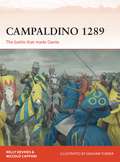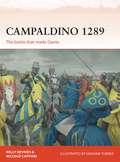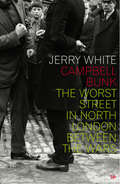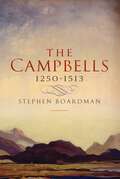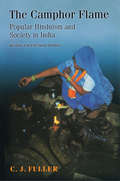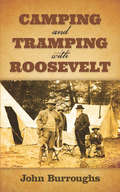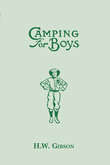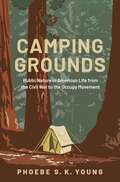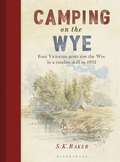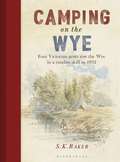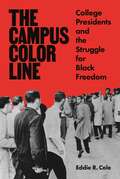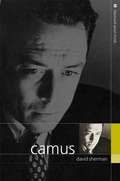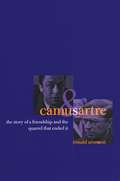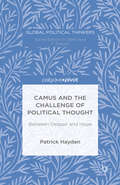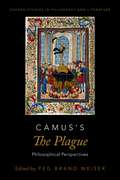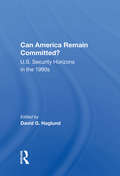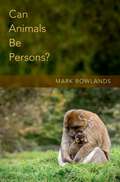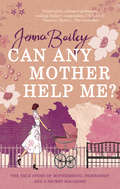- Table View
- List View
Campaldino 1289: The battle that made Dante (Campaign #324)
by Bounford.com Bounford.com Mr Graham Turner Paul Kime Kelly DeVries Niccolò CapponiCampaldino is one of the important battles between the Guelphs and Ghibellines - the major political factions in the city states of central and northern Italy. It heralded the rise of Florence to a dominant position over the area of Tuscany and was one of the last occassions when the Italian city militias contested a battle, with the 14th century seeing the rise of the condottiere in Italy's Wars.In this highly illustrated new study, renowned medieval historians Kelly De Vries and Niccolò Capponi have uncovered new material from the battlefield itself, as well as using all the available sources, to breathe new life into this colourful and fascinating battle.
Campaldino 1289: The battle that made Dante (Campaign)
by Graham Turner Bounford.com Bounford.com Paul Kime Kelly DeVries Niccolò CapponiCampaldino is one of the important battles between the Guelphs and Ghibellines - the major political factions in the city states of central and northern Italy. It heralded the rise of Florence to a dominant position over the area of Tuscany and was one of the last occassions when the Italian city militias contested a battle, with the 14th century seeing the rise of the condottiere in Italy's Wars.In this highly illustrated new study, renowned medieval historians Kelly De Vries and Niccolò Capponi have uncovered new material from the battlefield itself, as well as using all the available sources, to breathe new life into this colourful and fascinating battle.
Campbell Bunk: The Worst Street in North London Between the Wars
by Jerry WhiteFrom the 1880s to the Second World War, Campbell Road, Finsbury Park (known as Campbell Bunk), had a notorious reputation for violence, for breeding thieves and prostitutes, and for an enthusiastic disregard for law and order. It was the object of reform by church, magistrates, local authorities, and social scientists, who left many traces of their attempts to improve what became known as 'the worst street in North London'. Jerry White offers insight into the realities of life in a 'slum' community, showing how it changed over a 90-year period. Using extensive oral history to describe in detail the years between the wars, White reveals the complex tensions between the new world opening up and the street's traditional culture of economic individualism, crime, street theatre, and domestic violence.
The Campbells
by Stephen BoardmanIf not perhaps the most popular Highland clan, the Campbells are undoubtedly one of the most successful. The Campbell earls of Argyll have traditionally enjoyed a rather unsavoury historical reputation, viewed by their rivals with a mixture of fear, envy and respect. The spectacular advance of Campbell power in the medieval Scottish kingdom has normally been explained in terms of the family's ruthless and duplicitous suppression of their fellow-Gaels in Argyll and the Hebrides at the behest of the Scottish crown. In particular, Clan Campbell's success is seen to be built on the destruction of older and more prestigious regional lordships in the west, such as those of the MacDougall lords of Argyll and the MacDonald lords of the Isles. This book reassesses these negative images and interpretations of the growth of Campbell authority. The lords who dominated the medieval Clan Campbell emerge more as individuals enjoying complex and ambiguous relationships with the Scottish crown and the culture and politics of Gaelic-speaking Scotland, rather than as unquestioning agents of the Stewart monarchy and committed converts to the aristocratic culture of lowland Scotland.
The Camphor Flame: Popular Hinduism and Society in India - Revised and Expanded Edition (PDF)
by C. J. FullerPopular Hinduism is shaped, above all, by worship of a multitude of powerful divine beings--a superabundance indicated by the proverbial total of 330 million gods and goddesses. The fluid relationship between these beings and humans is a central theme of this rich and accessible study of popular Hinduism in the context of the society of contemporary India. Lucidly organized and skillfully written, The Camphor Flame brings clarity to an immensely complicated subject. C. J. Fuller combines ethnographic case studies with comparative anthropological analysis and draws on textual and historical scholarship as well. The book's new afterword brings the study up-to-date by examining the relationship between popular Hinduism and contemporary Hindu nationalism.
Camping and Tramping with Roosevelt
by John BurroughsIn 1903, a renowned naturalist joined the President of the United States for a two-week camping trip to Yosemite. John Burroughs offers these delightful reminiscences of Theodore Roosevelt, which center on their ramble through America's first national park and their shared joy in the region's wildlife and geologic wonders. The two observed gophers, badgers, elk, mountain sheep, black-tailed deer, and birds of all kinds while camping in picturesque wilderness settings. "I found his interest in bird life very keen, and his eye and ear remarkably quick," notes Burroughs of his friend, adding, "His training as a big-game hunter stood him in good stead, but back of that were his naturalist's instincts, and his genuine love of all forms of wildlife."Burroughs' account offers a splendid firsthand portrait of the larger-than-life president, recapturing Roosevelt's inexhaustible energy, infinite curiosity, and convivial personality. A second, briefer sketch recounts a visit to Sagamore Hill, the "summer White House," where the President and his companion took a walk in the woods to identify local birds. Twelve historic black-and-white photographs complement this engaging memoir.
Camping for Boys
by H W GibsonDo you know how to make a camp bed, test the freshness of an egg or light a match when there is nothing to strike it on? From setting up camp to choosing a motto, treating blisters to making a bow and arrow, Camping for Boys will ensure a happy, healthy time is had by all when out of doors. First published in 1913 in an era before televisions and video games, Camping for Boys was an indispensable guide for any young boy wanting to make the most of the great outdoors. With sections on games for a rainy day, first aid, cooking, building and maintaining the campfire, nature study, forecasting the weather, building a hygienic camp toilet, organisation, leadership and discipline, this valuable little book will help big kids to regain their youth and experience the thrill of the wind in their hair. Also suitable for armchair campers.
Camping Grounds: Public Nature in American Life from the Civil War to the Occupy Movement
by Phoebe S.K. YoungAn exploration of the hidden history of camping in American life that connects a familiar recreational pastime to camps for functional needs and political purposes. Camping appears to be a simple proposition, a time-honored way of getting away from it all. Pack up the car and hit the road in search of a shady spot in the great outdoors. For a modest fee, reserve the basic infrastructure--a picnic table, a parking spot, and a place to build a fire. Pitch the tent and unroll the sleeping bags. Sit under the stars with friends or family and roast some marshmallows. This book reveals that, for all its appeal, the simplicity of camping is deceptive, its history and meanings far from obvious. Why do some Americans find pleasure in sleeping outside, particularly when so many others, past and present, have had to do so for reasons other than recreation? Never only a vacation choice, camping has been something people do out of dire necessity and as a tactic of political protest. Yet the dominant interpretation of camping as a modern recreational ideal has obscured the connections to these other roles. A closer look at the history of camping since the Civil War reveals a deeper significance of this American tradition and its links to core beliefs about nature and national belonging. Camping Grounds rediscovers unexpected and interwoven histories of sleeping outside. It uses extensive research to trace surprising links between veterans, tramps, John Muir, African American freedpeople, Indian communities, and early leisure campers in the nineteenth century; tin-can tourists, federal campground designers, Depression-era transients, family campers, backpacking enthusiasts, and political activists in the twentieth century; and the crisis of the unsheltered and the tent-based Occupy Movement in the twenty-first. These entwined stories show how Americans camp to claim a place in the American republic and why the outdoors is critical to how we relate to nature, the nation, and each other.
Camping Grounds: Public Nature in American Life from the Civil War to the Occupy Movement
by Phoebe S.K. YoungAn exploration of the hidden history of camping in American life that connects a familiar recreational pastime to camps for functional needs and political purposes. Camping appears to be a simple proposition, a time-honored way of getting away from it all. Pack up the car and hit the road in search of a shady spot in the great outdoors. For a modest fee, reserve the basic infrastructure--a picnic table, a parking spot, and a place to build a fire. Pitch the tent and unroll the sleeping bags. Sit under the stars with friends or family and roast some marshmallows. This book reveals that, for all its appeal, the simplicity of camping is deceptive, its history and meanings far from obvious. Why do some Americans find pleasure in sleeping outside, particularly when so many others, past and present, have had to do so for reasons other than recreation? Never only a vacation choice, camping has been something people do out of dire necessity and as a tactic of political protest. Yet the dominant interpretation of camping as a modern recreational ideal has obscured the connections to these other roles. A closer look at the history of camping since the Civil War reveals a deeper significance of this American tradition and its links to core beliefs about nature and national belonging. Camping Grounds rediscovers unexpected and interwoven histories of sleeping outside. It uses extensive research to trace surprising links between veterans, tramps, John Muir, African American freedpeople, Indian communities, and early leisure campers in the nineteenth century; tin-can tourists, federal campground designers, Depression-era transients, family campers, backpacking enthusiasts, and political activists in the twentieth century; and the crisis of the unsheltered and the tent-based Occupy Movement in the twenty-first. These entwined stories show how Americans camp to claim a place in the American republic and why the outdoors is critical to how we relate to nature, the nation, and each other.
Camping on the Wye
by Mr S. K. Baker Mr Michael GoffeDuring their university holidays in the late 1880s, S.K. Baker and three of his University College friends clad in stripy blazers and boaters spent time sailing and camping on the River Wye. Baker, a keen artist and diarist, recorded their travels in watercolour in two small leather bound books.The result is an entirely charming, funny account along the lines of the legendary Three Men in a Boat with which the notebooks are entirely contemporaneous although the protagonists are younger and possibly naughtier. Baker records their evenings in the pub, their encounters with girls, (both ashore and afloat), nude swimming and culinary disasters, while recording lovingly the landscape and the boats on which they sailed.The notebook is published as a facsimile with an introduction by Michael Goffe, the son of one of Baker's fellow students (GG in the text), to whom it was gifted.
Camping on the Wye
by S. K. Baker Michael GoffeDuring their university holidays in the late 1880s, S.K. Baker and three of his University College friends clad in stripy blazers and boaters spent time sailing and camping on the River Wye. Baker, a keen artist and diarist, recorded their travels in watercolour in two small leather bound books.The result is an entirely charming, funny account along the lines of the legendary Three Men in a Boat with which the notebooks are entirely contemporaneous although the protagonists are younger and possibly naughtier. Baker records their evenings in the pub, their encounters with girls, (both ashore and afloat), nude swimming and culinary disasters, while recording lovingly the landscape and the boats on which they sailed.The notebook is published as a facsimile with an introduction by Michael Goffe, the son of one of Baker's fellow students (GG in the text), to whom it was gifted.
The Campus Color Line: College Presidents and the Struggle for Black Freedom
by Eddie R. Cole"A stunning and ambitious origins story."—Ibram X. Kendi, National Book Award–winning and #1 New York Times–bestselling authorThe remarkable history of how college presidents shaped the struggle for racial equalitySome of America’s most pressing civil rights issues—desegregation, equal educational and employment opportunities, housing discrimination, and free speech—have been closely intertwined with higher education institutions. Although it is commonly known that college students and other activists, as well as politicians, actively participated in the fight for and against civil rights in the middle decades of the twentieth century, historical accounts have not adequately focused on the roles that the nation’s college presidents played in the debates concerning racism. Based on archival research conducted at a range of colleges and universities across the United States, The Campus Color Line sheds light on the important place of college presidents in the struggle for racial parity.Focusing on the period between 1948 and 1968, Eddie Cole shows how college presidents, during a time of violence and unrest, strategically, yet often silently, initiated and shaped racial policies and practices inside and outside of the educational sphere. With courage and hope, as well as malice and cruelty, college presidents positioned themselves—sometimes precariously—amid conflicting interests and demands. Black college presidents challenged racist policies as their students demonstrated in the streets against segregation, while presidents of major universities lobbied for urban renewal programs that displaced Black communities near campus. Some presidents amended campus speech practices to accommodate white supremacist speakers, even as other academic leaders developed the nation’s first affirmative action programs in higher education.The Campus Color Line illuminates how the legacy of academic leaders’ actions continues to influence the unfinished struggle for Black freedom and racial equity in education and beyond.
Camus (Blackwell Great Minds)
by David ShermanReflecting the profound influence he continues to exert on popular consciousness, Camus examines the complete body of works of French author and philosopher Albert Camus, providing a comprehensive analysis of Camus’ most important works—most notably The Myth of Sisyphus, The Stranger, The Fall, The Plague, and The Rebel—within the framework of his basic ethical orientation. Makes Camus’ concerns clear in terms that will resonate with contemporary readers Reveals the unity and integrity of Camus’ writings and political activities Discusses Camus’ ongoing relevance by showing how he prefigures many postmodern positions in philosophy, literature, and politics
Camus and Sartre: The Story of a Friendship and the Quarrel that Ended It
by Ronald AronsonUntil now it has been impossible to read the full story of the relationship between Albert Camus and Jean-Paul Sartre. Their dramatic rupture at the height of the Cold War, like that conflict itself, demanded those caught in its wake to take sides rather than to appreciate its tragic complexity. Now, using newly available sources, Ronald Aronson offers the first book-length account of the twentieth century's most famous friendship and its end. Albert Camus and Jean-Paul Sartre first met in 1943, during the German occupation of France. The two became fast friends. Intellectual as well as political allies, they grew famous overnight after Paris was liberated. As playwrights, novelists, philosophers, journalists, and editors, the two seemed to be everywhere and in command of every medium in post-war France. East-West tensions would put a strain on their friendship, however, as they evolved in opposing directions and began to disagree over philosophy, the responsibilities of intellectuals, and what sorts of political changes were necessary or possible. As Camus, then Sartre adopted the mantle of public spokesperson for his side, a historic showdown seemed inevitable. Sartre embraced violence as a path to change and Camus sharply opposed it, leading to a bitter and very public falling out in 1952. They never spoke again, although they continued to disagree, in code, until Camus's death in 1960. In a remarkably nuanced and balanced account, Aronson chronicles this riveting story while demonstrating how Camus and Sartre developed first in connection with and then against each other, each keeping the other in his sights long after their break. Combining biography and intellectual history, philosophical and political passion, Camus and Sartre will fascinate anyone interested in these great writers or the world-historical issues that tore them apart.
Camus and the Challenge of Political Thought: Between Despair and Hope (Global Political Thinkers)
by P. HaydenAlbert Camus was a formative artist, writer and public figure whose work defies conventional labels, and whose legacy is controversial but substantial. His distinctive contribution to modern ethical and political thought remains far from settled. Camus and the Challenge of Political Thought comprehensively yet concisely explores how Camus's compelling ideas of absurdity and rebellion emerged, how his complex political engagements and positions developed, and how his conception of an ethics of limits and measure retains a vital, contemporary resonance in an era of unsettling global politics. Drawing upon the full range of Camus's notebooks, novels, plays and philosophical essays, Hayden shows Camus to be an original political thinker of human dignity and freedom whose life and work sought to navigate between the twin dangers of idealistic optimism and nihilistic despair.
Camus' Answer: 'No' to the Western Pharisees Who Impose Reason on Reality
by Robert TrundleAlthough Camus was called the "conscience of his age", no writer has continued to be both more vilified and exalted in the West. His writings are not only a devastating critique of Western philosophy, but Camus' cultural horizons are infused with heartfelt insights of Eastern wisdom. Western culture is vulnerable to dilemmas of existence because it seeks to make abstract certain absolutes: The West has failed to come to grips with our finite existential condition. Indian thought distinguishes social, political, scientific and philosophical views of Reality from Reality itself. And this distinction evokes a hope, humility and spirituality that promotes a courage to live with truths not faced by the West. This book is a gateway to investigating whether Camus' ideal of living without conceptual absolutes is an attainable goal. Intriguingly, his writings touch upon a freedom from the anxiety of living that raise a spectre of Eastern philosophical horizons. Camus' insights in terms of the East are present in his fictional illustrations of alienated twentieth-century outsiders (The Stranger); the pursuit of truths that are not immutable and absolute (The Myth of Sisyphus); plays that highlight the absurdity of irrational views of Reality (Caligula); culminating in The Rebel, which warned of illusory dogmas of absolutist philosophies.
Camus's The Plague: Philosophical Perspectives (OXFORD STUDIES IN PHIL AND LIT SERIES)
by Peg Brand WeiserLa Peste (in English The Plague), originally published in 1947 by the Nobel Prize-winning writer Albert Camus, chronicles the progression of deadly bubonic plague as it spreads through the quarantined Algerian city of Oran. While most discussions of fictional examples within aesthetics are either historical or hypothetical, Camus offers an example of "pestilence fiction." Camus chose fiction to convey facts--about plagues in the past, his own bout with tuberculosis at age seventeen, living under quarantine away from home for several years, and forced separation from his wife who remained in Algiers while he was abroad in Nazi-occupied France. His own lived experiences undergird an imaginative account of shared human realities with which we can identify: vulnerability to the disease, isolation, fear, and finally humanitarianism. The Plague teaches us to neither covet nor expect what we so casually took for granted. This collection of original essays on philosophical themes in The Plague is of special relevance during and in the aftermath of Covid-19 but also provides reflections that will be of lasting value to those interested in this classic work of literature. The novel explores questions of enduring importance. Do we collectively meet the threshold of ethical behaviour posed by Camus who wrote, "What's true of all the evils in the world is true of plague as well. It helps men to rise above themselves"? Or does the absurd undermine the compassionate? Do "heroes" dutifully fight a plague with "common decency," or does human nature resign itself to the normalization of uncontrollable suffering and death? There are myriad ways to approach the novel and this volume encourages readers to ponder human dilemmas in fictional Oran informed by our current pandemic.
Camus's The Plague: Philosophical Perspectives (OXFORD STUDIES IN PHIL AND LIT SERIES)
La Peste (in English The Plague), originally published in 1947 by the Nobel Prize-winning writer Albert Camus, chronicles the progression of deadly bubonic plague as it spreads through the quarantined Algerian city of Oran. While most discussions of fictional examples within aesthetics are either historical or hypothetical, Camus offers an example of "pestilence fiction." Camus chose fiction to convey facts--about plagues in the past, his own bout with tuberculosis at age seventeen, living under quarantine away from home for several years, and forced separation from his wife who remained in Algiers while he was abroad in Nazi-occupied France. His own lived experiences undergird an imaginative account of shared human realities with which we can identify: vulnerability to the disease, isolation, fear, and finally humanitarianism. The Plague teaches us to neither covet nor expect what we so casually took for granted. This collection of original essays on philosophical themes in The Plague is of special relevance during and in the aftermath of Covid-19 but also provides reflections that will be of lasting value to those interested in this classic work of literature. The novel explores questions of enduring importance. Do we collectively meet the threshold of ethical behaviour posed by Camus who wrote, "What's true of all the evils in the world is true of plague as well. It helps men to rise above themselves"? Or does the absurd undermine the compassionate? Do "heroes" dutifully fight a plague with "common decency," or does human nature resign itself to the normalization of uncontrollable suffering and death? There are myriad ways to approach the novel and this volume encourages readers to ponder human dilemmas in fictional Oran informed by our current pandemic.
Can America Remain Committed?: U.s. Security Horizons In The 1990s
by David G. HaglundThe twelve months that spanned the period between the early springtimes of 1991 and 1992 may well turn out to constitute the most important year for American foreign and security policy in half a century. Encasing the dawning of a new and different security era, like macabre parentheses, were two columns of black smoke-that of 1991 over the newly liberated Kuwait, and that of 1992 over the embattled district of South-Central Los Angeles. Within these acrid temporal brackets unfolded a set of developments of utmost significance for American foreign and security policy and for the very meaning of the country's external commitments.
Can America Remain Committed?: U.s. Security Horizons In The 1990s
by David G. HaglundThe twelve months that spanned the period between the early springtimes of 1991 and 1992 may well turn out to constitute the most important year for American foreign and security policy in half a century. Encasing the dawning of a new and different security era, like macabre parentheses, were two columns of black smoke-that of 1991 over the newly liberated Kuwait, and that of 1992 over the embattled district of South-Central Los Angeles. Within these acrid temporal brackets unfolded a set of developments of utmost significance for American foreign and security policy and for the very meaning of the country's external commitments.
Can Animals Be Persons?
by Mark RowlandsCan animals be persons? To this question, scientific and philosophical consensus has taken the form of a resounding, 'No!' In this book, Mark Rowlands disagrees. Not only can animals be persons, many of them probably are. Taking, as his starting point, John Locke's classic definition of a person, as "a thinking intelligent being, that has reason and reflection, and can consider itself the same thinking thing, in different times and places," Rowlands argues that many animals can satisfy all of these conditions. A person is an individual in which four features coalesce: consciousness, rationality, self-awareness and other-awareness, and many animals are such individuals. Consciousness--something that is like to have an experience--is widely distributed through the animal kingdom. Many animals are capable of both causal and logical reasoning. Many animals are also self-aware, since a form of self-awareness is essentially built into the possession of conscious experience. And some animals are capable of a kind of awareness of the minds of others, quite independently of whether they possess a theory of mind. This is not just a book about animals, however. As well as being fascinating in their own right, animals, as Claude Levi-Strauss once put it, are "good to think." In this seamless interweaving of the empirical study of animal minds with philosophy and its history, this book makes a powerful case for the idea that reflection on animals allows us to better understand each of these four pillars of personhood, and so illuminates what means for any individual--animal or human--to be conscious, rational, self- and other-aware.
Can Animals Be Persons?
by Mark RowlandsCan animals be persons? To this question, scientific and philosophical consensus has taken the form of a resounding, 'No!' In this book, Mark Rowlands disagrees. Not only can animals be persons, many of them probably are. Taking, as his starting point, John Locke's classic definition of a person, as "a thinking intelligent being, that has reason and reflection, and can consider itself the same thinking thing, in different times and places," Rowlands argues that many animals can satisfy all of these conditions. A person is an individual in which four features coalesce: consciousness, rationality, self-awareness and other-awareness, and many animals are such individuals. Consciousness--something that is like to have an experience--is widely distributed through the animal kingdom. Many animals are capable of both causal and logical reasoning. Many animals are also self-aware, since a form of self-awareness is essentially built into the possession of conscious experience. And some animals are capable of a kind of awareness of the minds of others, quite independently of whether they possess a theory of mind. This is not just a book about animals, however. As well as being fascinating in their own right, animals, as Claude Levi-Strauss once put it, are "good to think." In this seamless interweaving of the empirical study of animal minds with philosophy and its history, this book makes a powerful case for the idea that reflection on animals allows us to better understand each of these four pillars of personhood, and so illuminates what means for any individual--animal or human--to be conscious, rational, self- and other-aware.
Can Any Mother Help Me?
by Jenna BaileyIn 1935, a young woman wrote a letter to Nursery World magazine, expressing her feelings of isolation and loneliness. Women from all over the country experiencing similar frustrations wrote back. To create an outlet for their abundant ideas and opinions they started a private magazine, The Cooperative Correspondence Club. The deep friendships formed through its pages ensured the magazine continued until 1990, fifty-five years after the first issue was put together.
Can Common People Govern?: Political Parties, Movements, and Uprisings (Marx and Marxisms)
by Jacques BidetIn Can Common People Govern?, the renowned French social theorist, philosopher, and historian Jacques Bidet offers a theoretical and political exploration of political parties, movements, and uprisings as forms of popular political organization. He highlights the contradictions of the party-form and the movement-form through a critical analysis of Lenin, Xi Jinping, Gramsci, Althusser, and the theorists of left-wing populism, Laclau and Mouffe. Popular political organization, he argues, must be related to the structure of modern society, in which the popular class is opposed in a “triangular duel” against a dominant class that includes two poles in conflictual connivance, “capitalpower” and “competence-power” (or “elite”). This duality offers the common people an angle of attack for a risky alliance with this elite against capital. This class confrontation is put in the context of the ongoing ecological disaster and popular uprisings. In the age of disaster, environmentalism and social emancipation must be conceived as one and the same thing.Can Common People Govern? is relevant to students of Marxism as well as wider readership interested in political thought and action.
Can Common People Govern?: Political Parties, Movements, and Uprisings (Marx and Marxisms)
by Jacques BidetIn Can Common People Govern?, the renowned French social theorist, philosopher, and historian Jacques Bidet offers a theoretical and political exploration of political parties, movements, and uprisings as forms of popular political organization. He highlights the contradictions of the party-form and the movement-form through a critical analysis of Lenin, Xi Jinping, Gramsci, Althusser, and the theorists of left-wing populism, Laclau and Mouffe. Popular political organization, he argues, must be related to the structure of modern society, in which the popular class is opposed in a “triangular duel” against a dominant class that includes two poles in conflictual connivance, “capitalpower” and “competence-power” (or “elite”). This duality offers the common people an angle of attack for a risky alliance with this elite against capital. This class confrontation is put in the context of the ongoing ecological disaster and popular uprisings. In the age of disaster, environmentalism and social emancipation must be conceived as one and the same thing.Can Common People Govern? is relevant to students of Marxism as well as wider readership interested in political thought and action.
